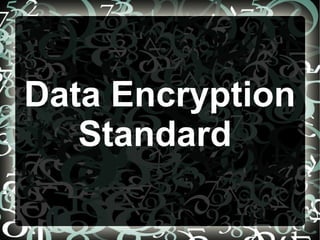Denunciar
Compartir

Recomendados
Cryptography and Network Security William Stallings Lawrie BrownCryptography and Network Security William Stallings Lawrie Brown

Cryptography and Network Security William Stallings Lawrie BrownInformation Security Awareness Group
Más contenido relacionado
La actualidad más candente
Cryptography and Network Security William Stallings Lawrie BrownCryptography and Network Security William Stallings Lawrie Brown

Cryptography and Network Security William Stallings Lawrie BrownInformation Security Awareness Group
La actualidad más candente (20)
Cryptography and Network Security William Stallings Lawrie Brown

Cryptography and Network Security William Stallings Lawrie Brown
Information and data security block cipher and the data encryption standard (...

Information and data security block cipher and the data encryption standard (...
3. The Data Encryption Standard (DES) and Alternatives

3. The Data Encryption Standard (DES) and Alternatives
Similar a Des
Similar a Des (20)
Performance Analysis of Data Encryption Standard DES

Performance Analysis of Data Encryption Standard DES
Enhancement of DES Algorithm with Multi State Logic

Enhancement of DES Algorithm with Multi State Logic
Information and network security 20 data encryption standard des

Information and network security 20 data encryption standard des
International Journal of Engineering Research and Development (IJERD)

International Journal of Engineering Research and Development (IJERD)
AssignmentThe purpose of this assignment is to get you familiar .docx

AssignmentThe purpose of this assignment is to get you familiar .docx
Más de Anshul Sharma
Más de Anshul Sharma (12)
Des
- 1. Data Encryption Standard
- 2. Introduction ● The Data Encryption Standard (DES) is a symmetric-key block cipher published by the National Institute of Standards and Technology (NIST). ● In 1973, NIST published a request for proposals for a national symmetric-key cryptosystem. A proposal from IBM, a modification of a project called Lucifer, was accepted as DES. DES was published in the Federal Register in March 1975 as a draft of the Federal Information Processing Standard (FIPS).
- 3. Overview DES is a block cipher, as shown in Figure 6.1.
- 5. Initial and Final Permutation
- 6. Intial and final permutation tables
- 7. The initial and final permutations are straight P- boxes that are inverses of each other. They have no cryptography significance in DES.
- 9. DES function The heart of DES is the DES function. The DES function applies a 48-bit key to the rightmost 32 bits to produce a 32-bit output.
- 10. Expansion P-box Since RI−1 is a 32-bit input and KI is a 48-bit key, we first need to expand RI−1 to 48 bits. Although the relationship between the input and output can be defined mathematically, DES uses Table to define this P-box.
- 12. (XOR) After the expansion permutation, DES uses the XOR operation on the expanded right section and the round key. Note that both the right section and the key are 48-bits in length. Also note that the round key is used only in this operation.
- 13. S-Boxes
- 14. S-Box Rule
- 15. S-Box 1
- 17. Algorithm for DES Cipher(plain[64],keys[16,48],cipher[64]){ permute(64,64,plain,inblock,IniPerTab) split(64,32,inblock,left,right) for(round =1 to 16) { mixer(left,right,keys[i]) if(round!=16) swapper(left,right) } combine(32,64,left,right,outblock) permute(64,64,outblock,cipher,FinPerTab) }
- 18. mixer(left[32],right[32],keys[48]){ Copy(32,right,T1) function(T1,keys,T2) XOR(32,left,T2,T3) Copy(32,T3,right) } swapper(left[32],right[32]){ Copy(32,left,T) Copy(32,right,left) Copy(32,T,right) }
- 19. function(input[32],key[48],output[32]){ Permute(32,48,input,T1,ExpansionPerTab) XOR(48, T1, key, T2) substitute(T2,T3,SubstituteTab) Permute(32,32,T3,output,StraightPerTab) }
- 20. Completeness Effect ● One bit of cipher text depends upon more than one bit. ● And in DES the cipher text shows completeness effect.
- 21. References ● Behrouz Forouzan analysis
- 22. Thank You ● Find the presentation on:- www.slideshare.com/anshuljmi
